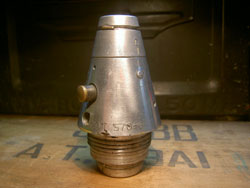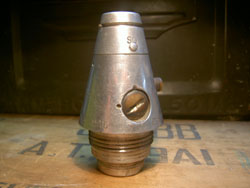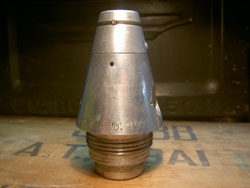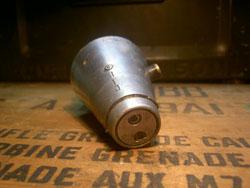Point-detonating Fuse M45.
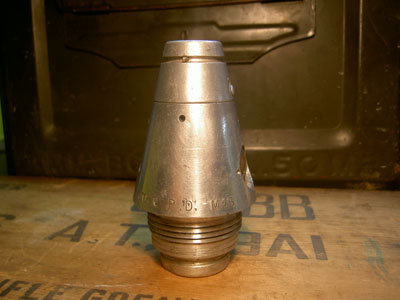
Description. The M45 Point-detonating Fuse is a selective, super quick, and delay action fuse, used to effect functioning of SHELL, H.E. M45, fired from the 81-mm trench mortar. This shell and fuse are now limited standard. The super quick setting is used when it is desired to obtain fragmentation of the shell above the ground, whereas the delay setting is used for underground action. The fuse weighs approximately 0.52 pounds.
The fuse housing is made of aluminum. The head of the fuse fits into the body so as to be able to turn on the body housing. The head houses a comparatively short, but wide, striker which is flush with the nose. The striker has two firing pins and is held in place by a shear wire. Underneath the firing pins is a super quick element and a delay element One element is directly in line with a flash hole to the body explosive charges, and the other element is in line with a dead flash hole depending on the setting. Located in the head are setting pins and setting pin springs which when in proper position for either delay or super quick setting will engage recesses in the body. On the external surface of the head is stamped "S.Q." or "D," to indicate the setting.
The body houses the slider, slider lock, safety pin, and set-back pin, with their respective springs. In the center and at the base of the body is an inverted brass cup known as a lead cup. It is held in place by crimping, and contains a tetryl lead pellet. The base of the body is internally threaded to receive a booster cup, which in turn houses a tetryl booster pellet. On the external surface of the body are a marked line and an identification pin which indicates the setting.
Setting - When set for super quick action the head is set so that the "S.Q ." stamped thereon is in line with the line on the body. Identification pins are provided for setting at night. These pins are so located that for super quick setting the heads of the pins are directly in line and for delay setting, they are 180 degrees removed. Pressure applied on the setting pin by the setting pin springs forces them to engage in recesses in the body at the exact position of "S.Q.," and "D" so as to restrain the head in proper position.
Safety features. The M45 Fuse is bore safe. This is accomplished by assembling the detonator into a slider which in the armed position holds the detonator out of alignment with the explosive train. Arming of the slider in the bore of the mortar is prevented by a safety pin, the head of which bears against the bore, thereby retaining the slider in the safe position. To prevent arming of the set-back pin, which holds the safety pin in position, a cotter pin is utilized, preventing the set-back pin from moving rearward against its spring during handling.
Function when set for super quick action. The cotter pin is removed, freeing the set-back pin. The shell is dropped down the bore of the weapon. The force of set-back resulting from ignition of the propelling charge causes the set-back pin to move down against the set-back pin spring, freeing the safety pin. The safety pin, due to the action of the safety pin spring, is forced out of the fuse until its head comes in contact with the bore of the mortar. After emerging from the mortar the safety pin is completely ejected by its spring from the fuse. The slider is now free, and due to the action of the slider spring is forced into the armed position, thereby bringing its detonator in direct alignment with the explosive train. The slider serves to close the hole left by the safety pin, so as to prevent the entrance of mud or dirt into the slider cavity which might interfere with the fuse functioning. The slider is locked in the armed position by a slider lock which is forced up into a recess in the slider by a slider lock spring.
Upon impact with the target the striker is forced inward, breaking the shear wire and carrying both firing pins into their respective elements. The super quick firing pin ignites a primer which in turn ignites a lead azide relay charge. The lead azide relay detonates, and sends a wave to the detonator charge of lead azide and tetryl in the slider. The wave from the detonator functions the lead charge of tetryl. The wave from the lead charge of tetryl detonates the booster of tetryl which amplifies the wave and sends it to the shell filler. Simultaneously with the above action, the delay firing pin functions its primer. If the super quick action functions properly, the delay action will proceed no farther. If the super quick fails to function, the primer will ignite a black powder pellet which will burn for 0.1 second. The flame from the black powder delay pellet in turn will set off a relay of lead azide which will detonate and carry a wave into a blank flash hole where it will be stopped and will proceed no farther.
Function on delay. The head must be turned so that the "D" stamped thereon is in line with the mark line on the body. By means of setting the head as described, the delay element is brought into alignment with the flash hole and the super quick primer is 180 degrees removed. The fuse function is exactly the same until action on impact.
Upon impact the striker is forced inward, breaking the shear wire, carrying both firing pins into their respective elements. The super quick firing pin ignites its primer which in turn sets off a relay of lead azide. The wave produced passes into a blank flash hole and proceeds no farther. Simultaneously with the above action, the delay firing pin functions its primer. The flash from the primer ignites a black powder delay pellet which burns for 0.1 second. The delay pellet ignites a relay of lead azide which detonates, and in turn sets off the detonator charge of lead azide and tetryl located in the slider. The wave from the detonator functions the lead charge of tetryl which detonates, and functions the booster of tetryl. The booster charge amplifies the wave and sends it to the shell filler.
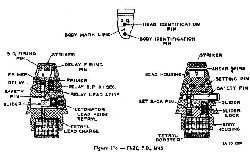
|




